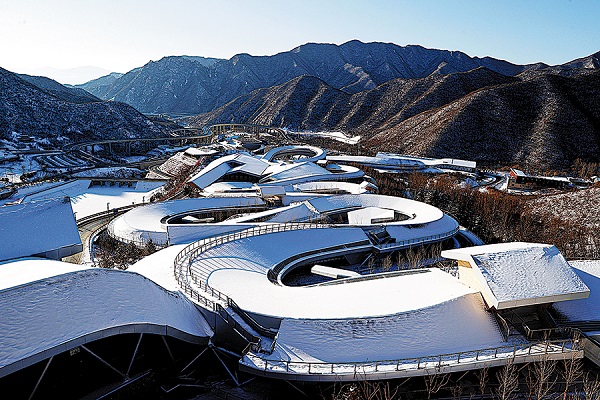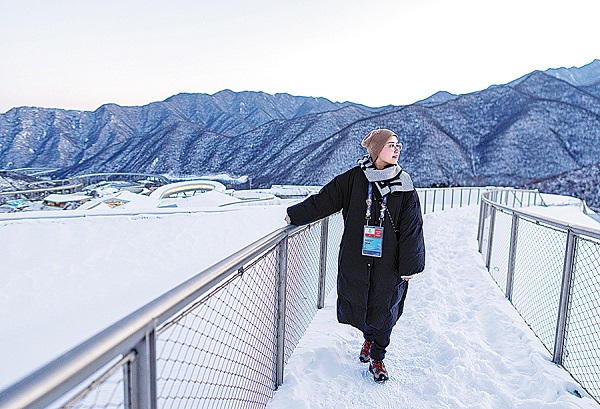Olympic track wows world and gives homegrown talents platform for success

The track at the National Sliding Centre in Yanqing goes by the name "Flying Snow Dragon", in reference to its winding appearance. GETTY IMAGES
With China's sudden emergence as an Olympic medal contender in sliding sports at Beijing 2022, the country's gleaming new National Sliding Centre in the Yanqing competition zone has also caught the attention of the world's winter sports community.
"We made huge efforts over the past six to seven years for the National Sliding Centre and everything has paid off," said Zhang Yuting, the designer of the venue in an interview with media next to the track on Monday.
"I always told people around me that we finally have our home track, and that can make a huge difference. What could be better? Our home track has world-class quality and design."
China had barely any history in sliding sports before Beijing won the Olympic bid in 2015, yet the nation set about building one of the world's longest sliding tracks in the capital's northwestern suburb Yanqing.
Constructed across the ridges of Xiaohaituo Mountain in Yanqing, the track features a first-of-its-kind 360-degree loop section, with a maximum gradient of 18 percent among 16 curves.
The track features a vertical drop of 120 meters between the start gate and the finish area, and the center can seat up to 2,000 spectators. Of all Beijing 2022's new venues, it was one of the most complicated projects to undertake.
"The most difficult part is that China never built or designed a sliding center like this before. We had no previous experience," said Zhang.
"The construction and the ice making on the track were unknown elements for us. So the question for us was how to finish all these from scratch."
Zhang and her team traveled abroad to observe and study other sliding tracks. The designer admitted that at the beginning of the project she even had to educate herself on the differences between luge, skeleton and bobsleigh.
"Actually, no two sliding tracks are exactly the same in the world. Tracks need to be customized based on the natural conditions of the location, including the weather, thermal radiation and wind. So we needed to find the best solution for the track design," Zhang explained.
Chinese luge, skeleton and bobsleigh riders have enjoyed impressive performances on their home track at Beijing 2022.
Yan Wengang has been the biggest success story so far, claiming bronze in the men's skeleton to earn the host its first Olympic medal in any sliding sport.
"We've gone down this track so many times so we entered the Games in confident mood. I've accumulated a lot of experience on the track and I'm confident on every corner," said Yan after his third-place finish.
"We're young and lack major-competition experience, but we've had very good results on the international circuit. I feel that psychologically, and in understanding the equipment, we still have room for improvement and that's something we can work on. We'll definitely become stronger."
Team Germany has maintained its dominance of sliding sports at Beijing 2022, claiming six golds across the luge and skeleton events.
The German riders gave the Yanqing track a ringing endorsement.
"I like the track very much and I like to slide down the track, but it's very difficult. Some curves are really, really hard for me, but the conditions are perfect, the ice is really good and I like it. But some curves, yeah, I tried to get better and better," said Germany's Tina Hermann, who finished fourth in the women's skeleton.

Zhang Yuting, designer of the National Sliding Centre. [Photo/China Daily]
Zhang says the track is the key to the overall design of the National Sliding Centre. The track weaves through the area's mountainous terrain, with the design team striking a balance between safety and making it challenging enough for the world's elite competitors.
"We wanted to respect sliding sports' tradition and logic, so we didn't design a track intent on creating a particular shape just so it looked good from overhead. The Shanghai International Circuit, for instance, was specifically made to resemble one of the Chinese characters of the city's name," said Zhang.
"So our main goal was to give the athletes the best experience, such as great acceleration, challenging turns and certain sections to relax a little bit after they have pushed the limits of their bodies. So the shape of track was designed with all these considerations and the shape of the mountain."
As well being a visual treat, the track's poetic name-the "Flying Snow Dragon"-has also won many fans.
"In May 2016 during one of our field trips here in the mountain, we noticed a small snake, which looked very similar to our track design. And in traditional Chinese culture, a snake was referred to as a 'small dragon'. That's why we gave the track that name," said Zhang.
"The inspiration of the design actually came from what we observed and felt in the mountain. And I think, as a Chinese designer, our culture is in my blood. So the design evokes Chinese culture."
- Top legislature schedules session for December
- China's top legislator holds talks with president of Luxembourg parliament
- China's top legislator meets with French president
- China, Maldives pledge to enhance exchanges between legislative bodies
- Senior Chinese legislator meets Portugal's PSD delegation



